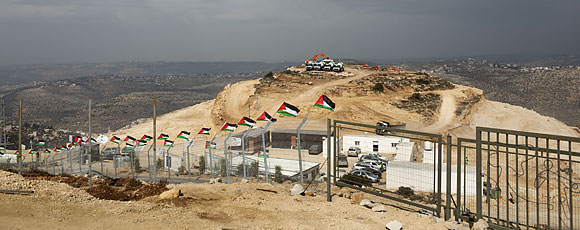
Construction is expected to generate 10,000 jobs
Sitting in his Ramallah office, Bashar Masri, managing director of Bayti Real Estate Investment Co., watches the construction of the first planned city in Palestinian history in real time on multiple split screens on his computer. When construction is complete, this craggy stretch of land 12 miles north of Jerusalem, about five miles from where he is, will be transformed into a modern, 40,000-person metropolis called Rawabi. "There is a lot of risk in a project like this," the man behind the ambitious undertaking says, in what can only be described as a huge understatement.
Masri is navigating uncharted territory. At $850 million, Rawabi (which means hills in Arabic) is both the largest construction project and the largest private foreign investment ever made in the Palestinian territories. Buyers can access up to $500 million in mortgage financing provided by a group of partners, including the U.S.-backed nonprofit Middle East Investment Initiative (MEII) and the Overseas Private Investment Corp., a U.S. development agency. It aims to do something rarely done in the Arab world — namely, provide affordable, desirable middle-class housing in a region where the wealth gap has led to conflict and revolution.
Designed under a master plan by the global architecture, engineering and urban-planning firm AECOM in conjunction with experts from the Palestinian universities Birzeit and An-Najah, Rawabi represents a marked departure from the traffic-clogged, haphazard urban sprawl of most other West Bank cities. Rawabi will be a sleek, wired city spread across more than 1,500 acres. It is being constructed as a high-tech, environmentally sustainable community of gleaming midrise buildings, public parks, cafés and shopping areas, with designated residential and commercial zones. It will feature a business district as well as a cultural center, an amphitheater, schools, mosques, churches and hospitals.
The development is expected to create more than 10,000 jobs. "When people can afford homes and they have jobs, that leads to stability," says James Pickup, MEII's president. The project has not been without hurdles. About 8% of Rawabi exists in Area C, turf that remains under Israeli military and civil control, which has made obtaining permits more complicated.
Masri was born in the northern West Bank city of Nablus, but it was while he was living in Washington after earning a degree in chemical engineering at Virginia Tech that he came to understand how homeownership was a path to asset building. "The first thing I did when I saved $5,000 was to buy a house for $99,000. I was able to do that because the system allowed you to do that if you had a job," he says.
The idea for Rawabi clicked when he considered his employees. While his workers earned an average of $1,900 a month, just 10% owned a home. Traditionally, those wishing to buy a house had to make a big up-front cash payment or take out a short-term adjustable high-interest personal loan — which, along with high property values, has priced out an estimated 85% of the population.
Rawabi is geared specifically to a woefully underserved sector: college-educated young professionals. The housing units are expected to cost $65,000 to $100,000 — 25% to 40% less than homes in the surrounding area. "The Arab world has long catered to the rich," says Masri. "It has ignored the majority, which is poor or middle income. This isn't rocket science. Homeownership is one of the most important issues for a young family to feel stable and secure."
That's the converse of what has happened in the West, where housing speculation fueled the financial meltdown. But in Gaza and the West Bank, the World Bank estimates that real, unmet demand will hit 400,000 to 450,000 units in the next 10 years. If successful, Rawabi offers a broader, smarter template for the West Bank and the rest of the Arab world.